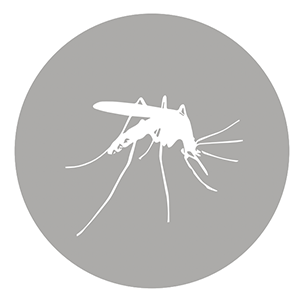Group 3. Diseases transmitted by mosquitoes
 |
Disease tools: 12. Chikungunya 13. Dengue fever 14. Malaria 15. Zika virus infection |
Mosquitoes transmit many diseases to humans when they penetrate the skin with their proboscis to draw blood. The diseases they transmit include chikungunya, dengue fever, malaria and Zika virus infection.
How are these diseases transmitted?
This group of diseases is transmitted by mosquitoes that carry germs. When mosquitoes bite someone, they insert the germs into the blood of that person, causing him or her to get the disease.
What symptoms do they cause?
The diseases in this group are caused by different germs. However, they all cause high fever, acute physical pain and tiredness. Malaria causes a fever that goes up and down, with spells of extreme fever and shivering. Dengue fever can sometimes cause bleeding of the gums and bleeding under the skin, in addition to fever. Zika virus disease includes mild fever, skin rash, conjunctivitis, muscle and joint pain, and malaise or headache. Chikungunya causes fever and severe joint pain and sometimes muscle pain, headache, nausea, fatigue and rash.
How do we prevent the spread of these diseases?
These diseases are controlled principally by preventing mosquitoes from breeding and biting humans. This is done in several simple ways:
a) Vector control
- Apply appropriate insecticide or larvicide to outdoor water storage containers.
- Prevent mosquitoes from breeding by covering domestic water storage containers and emptying and cleaning them every week.
- Take action to reduce the number of habitats suitable for egg-laying.
- Dispose of solid waste properly and remove mosquito habitats that are man-made.
b) Avoid contact with mosquitoes
- Protect yourself from physical contact with mosquitoes by using bed-nets, window screens, long-sleeved clothes and materials treated with insecticide.
How to deal with cases of these diseases?
Volunteers cannot treat people who are sick from a disease that mosquitoes have transmitted. Those who are sick need to be treated by health professionals in a health centre. Volunteers can help by identifying cases of high fever (suspected malaria or dengue fever) and referring them to health professionals. Depending on the diseases and tasks, volunteers may need to wear personal protection equipment, including insect repellent.
How to detect an epidemic?
When many more people than usual have a high fever combined with any of the other symptoms mentioned above, in a place known to have malaria, dengue fever, Zika virus disease or Chikungunya, an epidemic is suspected. It is the role of the health authorities to confirm an outbreak.
| The epidemic |
|---|
|
Who? Where? When? Why? |
How to deal with an epidemic?
If an epidemic of a disease transmitted by mosquitoes occurs in your community, you can take several actions:
- Build trust with members of the community.
- Involve members of the community in efforts to control the epidemic.
- Familiarize yourself with the culture of your community.
- Detect suspected cases and refer them to health facilities for treatment.
- Distribute mosquito nets and teach people how to use them.
- Teach members of the community how to identify the disease and protect themselves from mosquitoes.
- Control breeding sites, spray houses with insecticides, sleep under long-lasting insecticidal nets (LLINs).
- New vaccines and preventive medicines are being developed for some vector-borne diseases. These may be used in epidemics in the future.
What can volunteers do?
Managing an epidemic involves treating cases but also preventing the disease from spreading and slowing the epidemic down. Volunteers can play a major role in helping to slow epidemic diseases transmitted by mosquitoes.
You can:
- Distribute mosquito nets and teach the community how to use them.
- Mobilize members of the community to adopt safe practices and teach people to identify and prevent the diseases (using BCC).
- Monitor the disease through house-to-house visits.
- Refer cases to health facilities.
- Organize community clean-up campaigns to eliminate mosquito breeding sites.
- Participate in vector control, after receiving training, under the supervision of water and sanitation or vector control specialists.
- Give psychosocial support to sick people and their families.
Participate
Discuss in your group a possible mosquito-borne epidemic in your community. Look at the disease tools for mosquito-borne diseases and select the appropriate action and message tools for each. Discuss with your facilitator the similarities and differences between the tools for each disease in this category.
It is important to recognize that behaviour change and vector control are the most effective ways to end epidemics in this category. Discuss in your group how difficult vector control would be in your community.